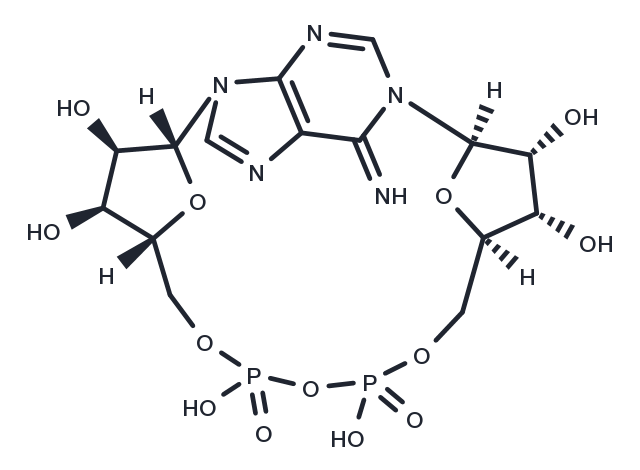Powder: -20°C for 3 years | In solvent: -80°C for 1 year


Cyclic ADP-ribose (cADPR) is an effective calcium mobilization second messenger, which is synthesized from NAD + by ADP-ribosyl cyclase. Cyclic ADP-ribose mainly increases cytosolic calcium through Ryanodine receptor-mediated endoplasmic reticulum release and extracellular influx caused by the opening of TRPM2 channels.

| Pack Size | Availability | Price/USD | Quantity |
|---|---|---|---|
| 25 mg | 6-8 weeks | $ 1,520.00 | |
| 50 mg | 6-8 weeks | $ 1,980.00 | |
| 100 mg | 6-8 weeks | $ 2,500.00 |
| Description | Cyclic ADP-ribose (cADPR) is an effective calcium mobilization second messenger, which is synthesized from NAD + by ADP-ribosyl cyclase. Cyclic ADP-ribose mainly increases cytosolic calcium through Ryanodine receptor-mediated endoplasmic reticulum release and extracellular influx caused by the opening of TRPM2 channels. |
| In vitro | In cells, cyclic ADP ribose (cADPR) plays an important role in the following processes: cell proliferation and differentiation, regulating for example the expansion of mesenchymal stem cells and hematopoietic progenitor cells, neuronal differentiation of PC12 cells and mouse embryonic stem cells Cardiomyocyte differentiation. |
| In vivo | In mammals, cyclic ADP-ribose (cADPR) plays an important role in the following processes: inflammation and immune response, including neutrophil chemotaxis and T cell activation; smooth muscle cell contraction in arteries and bronchial tubes, involved Hypoxic pulmonary vasoconstriction and the pathogenesis of inflammation / allergic airway diseases; myometrial contractility, which ultimately helps delivery; myocardial cell contraction in adult heart tissue, involved in angiotensin II and β-adrenaline Myocardial hypertrophy and arrhythmia caused by isoproterenol; endocrine and exocrine pancreatic secretion; social behavior of mice, including memory formation and spatial learning, are related to oxytocin secretion and may be related to niacin deficiency. In addition, cyclic ADP-ribose (cADPR) is involved in the activation and fertilization of eggs in seaweeds and sea urchins, early development of sea urchins, abscisic acid signaling in sponges and plants, cell fission in dinoflagellates, and pathogenicity of Toxoplasma gondii. |
| Synonyms | cADPR |
| Molecular Weight | 541.3 |
| Formula | C15H21N5O13P2 |
| CAS No. | 119340-53-3 |
Powder: -20°C for 3 years | In solvent: -80°C for 1 year
You can also refer to dose conversion for different animals. More
bottom
Please see Inhibitor Handling Instructions for more frequently ask questions. Topics include: how to prepare stock solutions, how to store products, and cautions on cell-based assays & animal experiments, etc.
Cyclic ADP-ribose 119340-53-3 Membrane transporter/Ion channel Metabolism Calcium Channel Cyclic ADPribose Cyclic ADP-ribose Cyclic ADP ribose cADPR inhibitor inhibit
